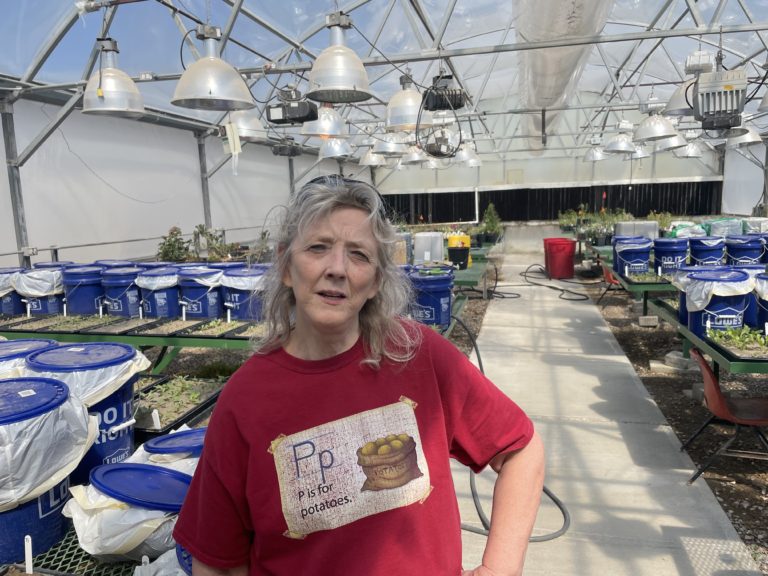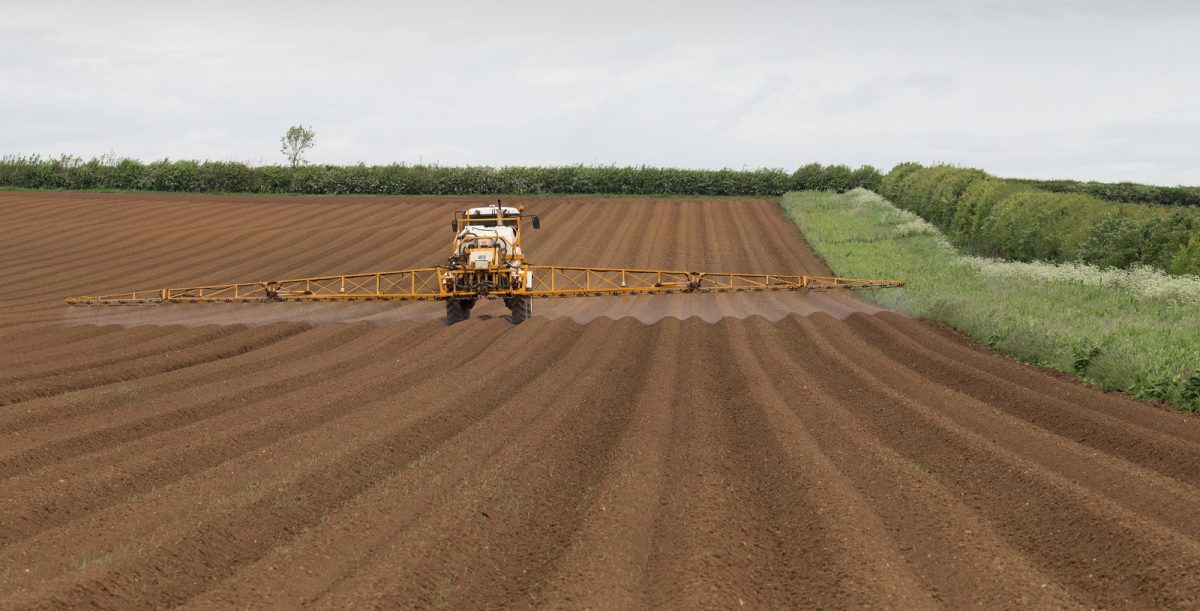Farmers throughout southern and eastern Idaho were befuddled by the bizarre symptoms of crop damage that surfaced in their potato fields following a brief period of heavy rainfall in May of 2017.
More odd symptoms – including swollen shoots, sprouts growing at a right angle, tuber folding and yellow veins in foliage – appeared in regional spud fields following another wet May in 2019.
Pam Hutchinson, University of Idaho (U of I) Extension potato cropping systems weed specialist, has diagnosed and studied the problem – heavy rains prior to potato emergence can move herbicides too deep into the soil, where they’re more accessible by shoots and tuber roots than usual, which could, in turn, cause crop damage. Hutchinson has developed good guidance for growers facing the challenge, now entering her third and final year of conducting simulated rainfall trials at the U of I Aberdeen Research and Extension Center.

Her simulated rainfall study has received funding from the Idaho Potato Commission and will be among several research projects highlighted during the U of I Snake River Weed Management Tour and Field Day, scheduled for 9 a.m. to noon on June 21 in Aberdeen and on June 22 at the U of I Kimberly Research and Extension Center. Three Idaho pesticide recertification credits will be available for each tour. Participants are asked to arrive a half hour early to register, and a sponsored lunch will follow the tours.
The weed tour was canceled last year and was hosted virtually during 2020 due to COVID-19. For her simulated rainfall trials, Hutchinson has been testing four preemergence herbicides: Matrix, Outlook, Prowl H2O and metribuzin. She’ll share findings of this season’s trials during U of I’s annual Idaho Potato Conference, hosted in January in Pocatello.
“I needed to learn what symptoms an herbicide could cause in that type of a situation with all of that excess rainfall,” Hutchinson said. “Over the years we’ve looked at and learned about herbicide damage under normal growing conditions.”
This season, she planted three 80-foot by 240-foot simulation test plots on May 2. She incorporates the herbicides with a half inch of water and follows during the final two weeks of May with either irrigation as needed, 3 inches of excess irrigation or 6 inches of excess irrigation to simulate rainfall conditions in 2017 and 2019.
During those springs, fields across southern Idaho, which has an average annual rainfall of roughly 10 inches, received 1 to 5 inches of rain in just two weeks. Some growers reported atypical symptoms such as shoots growing up from the tuber turning at a right angle for a few inches then straightening before emergence. Some had smaller spuds and lower yields, though most crops recovered from the herbicide damage by fall harvest.
“The potatoes were able to grow out of it and metabolize herbicide before tubers started forming,” Hutchinson said.
Crops in Hutchinson’s trials have also recovered well from the damage, though an early fall frost could shorten the season and sting growers, when coupled with early season herbicide damage. Hutchinson hopes to simulate an early frost in future rainfall research by killing vines ahead of schedule. Hutchinson will add a new element to this year’s trials: soil sampling to depths of a foot and with lab analysis, determining the depth to which herbicides have moved through the soil. Movement measured with these analyses can be correlated with crop injury seen or not seen.

She’s consistently planted Russet Burbank, which is considered tolerant to metribuzin herbicide. Nonetheless, yellowish veins – symptomatic of metribuzin damage – surfaced in foliage in her trials, as they did in some growers’ fields during the wet years. Heavy rainfall before spuds emerge can also cause poor weed control, as herbicides move too deeply and too quickly through soil to be absorbed by weed shoots and roots. In the wet years, many potato farmers had to apply postemergence herbicides they had not planned to use.
The risk of herbicide damage because of excess rainfall can be even more pronounced in fields with sandy soils, through which water and the more water-soluble potato herbicides such as Matrix and metribuzin, can infiltrate deeper than in heavier textured soils. Hutchinson works with growers who farm sandy soils and have developed weed control programs with the less water-soluble preemergence herbicides. The growers can keep a close eye on the initial weed control and follow up with postemergence herbicides if necessary.
“The trials reinforced even more so that if you have real sandy soil you’re going to have more downward herbicide movement than formerly understood when excess rainfall occurs,” Hutchinson said.
Ritchey Toevs, an Aberdeen potato farmer and a past chairman of the Idaho Potato Commission, believes lessons of Hutchinson’s research are valuable to farmers, even during normal growing seasons. “If we have a windy day and we’re not getting much water on and the wind makes it difficult to irrigate correctly, we’ll add a few more hours to the set, and we can duplicate a heavy rainfall, unaware of the damage we could be causing,” Toevs said.
– University of Idaho
Potato shoots in a grower’s field following heavy May 2019 rainfall grow at a right angle, likely due to herbicide damage. Photo: Pam Hutchinson, University of Idaho


